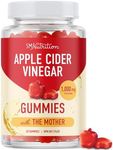Buying Guide for the Best Apple Cider Vinegars
Choosing the right apple cider vinegar can make a difference in both taste and health benefits. Whether you’re using it for cooking, as a salad dressing, or for its potential wellness properties, understanding the key features will help you select the best option for your needs. Focus on the source, processing method, and intended use to guide your decision.Raw vs. PasteurizedThis refers to whether the apple cider vinegar has been heated to kill bacteria and extend shelf life (pasteurized) or left in its natural state (raw). Raw apple cider vinegar contains the 'mother,' a cloudy substance with beneficial enzymes and probiotics, which many people seek for health reasons. Pasteurized versions are clear and may have a milder taste but lack these natural components. If you want the potential health benefits, choose raw; if you prefer a cleaner look and taste, pasteurized may be better.
With the MotherThe 'mother' is a collection of proteins, enzymes, and beneficial bacteria that forms naturally during fermentation. It looks cloudy or stringy in the bottle. Vinegars with the mother are often considered more nutritious and are preferred for wellness uses. If you’re interested in digestive health or using vinegar as a tonic, look for this feature. For cooking or cleaning, the presence of the mother is less important.
Organic CertificationOrganic apple cider vinegar is made from apples grown without synthetic pesticides or fertilizers. This is important if you want to avoid chemical residues and support environmentally friendly farming. Organic options are usually labeled clearly. If you prioritize natural ingredients and sustainability, choose organic; otherwise, conventional vinegar may suffice for general use.
Acidity LevelMost apple cider vinegars have an acidity of around 5%, which is standard for both taste and preservation. Higher acidity can make the vinegar more potent and tangy, while lower acidity is milder. If you’re using vinegar for pickling or preserving, stick to the standard 5%. For drinking or milder flavor, a lower acidity might be preferable.
Unfiltered vs. FilteredUnfiltered apple cider vinegar retains more of the natural particles and the mother, making it cloudier and richer in nutrients. Filtered vinegar is clear and free of solids, which some people prefer for appearance or certain recipes. If you want maximum health benefits, go for unfiltered; if you want a clear product for visual appeal or specific culinary uses, filtered is a better choice.
Packaging MaterialApple cider vinegar is commonly sold in glass or plastic bottles. Glass is non-reactive and preserves flavor and quality better, while plastic is lighter and less breakable but may interact with the vinegar over time. If you plan to store vinegar for a long time or value purity, glass is ideal. For convenience and portability, plastic may be sufficient.














